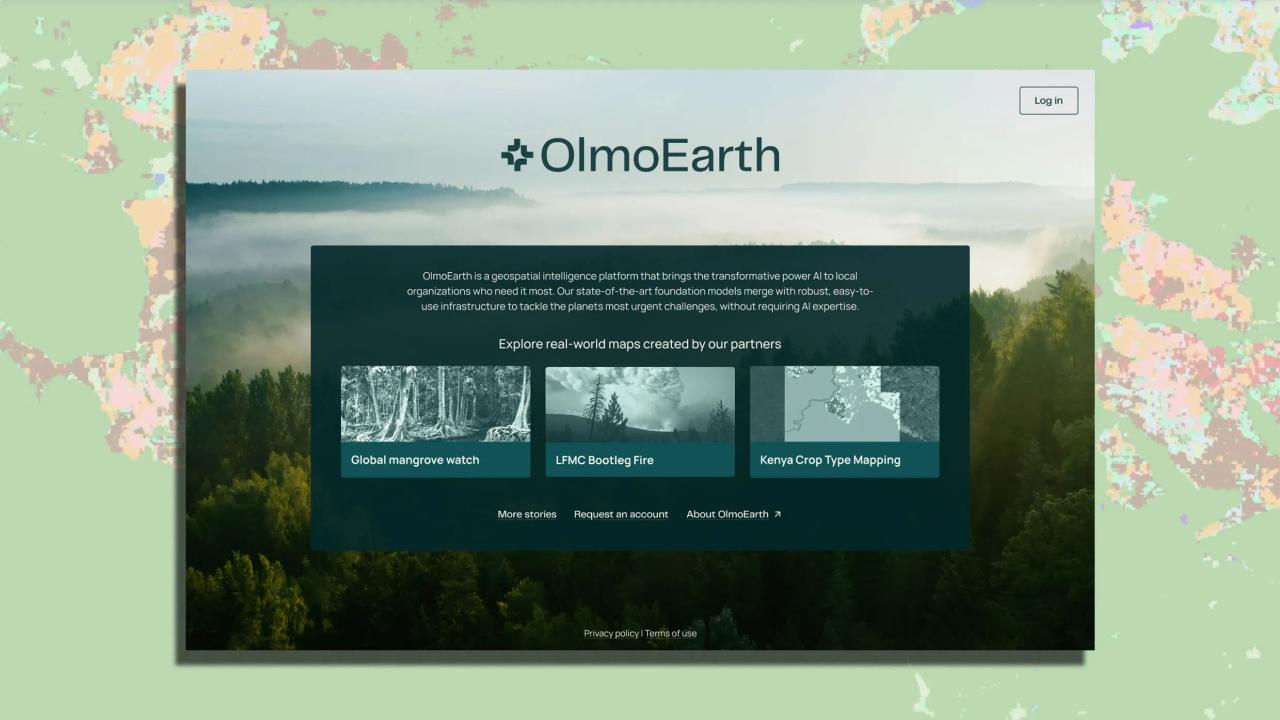Allen Institute for AI Launches OlmoEarth: Open-Source Platform Democratizes Earth Monitoring with AI
2 Sources
2 Sources
[1]
Ai2 loosens Big Tech's grip on Earth insights with open-source AI models for climate and conservation
A new platform from the Allen Institute for AI promises to deliver insights into the state of the planet, in near real-time, by giving organizations without deep AI expertise the ability to monitor deforestation, assess crop health, and predict wildfire risk, among other capabilities. OlmoEarth, announced Tuesday by the Seattle-based nonprofit AI institute, is an open, end-to-end system that uses AI to analyze current and historical satellite and sensor data. It runs on a new family of AI models, which Ai2 says it trained on millions of Earth observations totaling roughly 10 terabytes of data. The idea is to give anyone free access to the kinds of capabilities typically restricted to proprietary systems or well-resourced AI labs. The platform includes tools such as OlmoEarth Studio, a workspace for creating datasets and fine-tuning models, and OlmoEarth Viewer, a web app for exploring AI-generated maps. The initiative is "making Earth AI accessible to those working on the front lines," said Ali Farhadi, Ai2 CEO and University of Washington professor, in a press release announcing OlmoEarth. Patrick Beukema, lead researcher on the OlmoEarth team, added that the project is meant to encourage collaboration across scientific and technical fields, helping different groups work together on shared data and tools to better understand and respond to environmental challenges. Ai2 said early adopters of OlmoEarth are already showing the potential, using it to update global mangrove maps twice as fast with 97% accuracy, detect deforestation across the Amazon, and map vegetation dryness in Oregon to improve wildfire prediction and prevention, for example. It's the latest example of Ai2's push for "true openness" in AI, extending the philosophy behind its open-weight language and multimodal models into climate science and conservation. Geospatial analysis has long been dominated by major tech and research organizations. Platforms like Google Earth Engine and Microsoft's Planetary Computer provide cloud access to petabytes of satellite data, but often require significant technical expertise for analysis and are not fully open-source. Ai2 is positioning OlmoEarth as an end-to-end open alternative, providing not just data access but a complete, usable system for model fine-tuning and deployment. At the model level, Ai2 is competing with AI-specific tools from other major labs. In its research, Ai2 contrasts OlmoEarth with Google's AlphaEarth Foundations, noting that Google released "embeddings" rather than the open model itself. Ai2 says a fine-tuned OlmoEarth "outperformed AEF substantially," and also did well against models from Meta, IBM, and NASA. The OlmoEarth Viewer is available starting today, and Ai2 has released accompanying code and documentation on GitHub. The full platform, including OlmoEarth Studio, is rolling out to select partners, and Ai2 is inviting additional collaborations.
[2]
Paul Allen's AI nonprofit unveils satellite data platform
A new open AI platform from the nonprofit created by the late Microsoft cofounder Paul Allen aims to make satellite imagery and other data about the earth more available and useful. The Allen Institute for Artificial Intelligence (Ai2) on Tuesday unveiled the OlmoEarth Platform, backed by a family of AI foundation models trained on roughly 10 terabytes of data derived from millions of observations of the planet, including satellite images, radar readings, and existing maps of features like forest cover. The OlmoEarth models can then be fine-tuned for specific purposes, like detecting changes in vegetation, with the help of a companion software tool called OlmoEarth Studio. Details on model performance are included in a new scientific paper. Ai2 has already been working with a variety of organizations harnessing the AI, including groups looking to better assess and respond to wildfire risk. The International Food Policy Research Institute is using the technology to more frequently update maps of crops grown in one region of Kenya. Amazon Conservation is using the AI system to quickly spot deforestation. And a project called Global Mangrove Watch is harnessing the technology to more comprehensively track mangrove populations and quickly detect threats to those critical coastline trees. Patrick Beukema, lead researcher on Ai2's OlmoEarth team, says the project grew out of a realization that while AI can help put earth imagery and data to use by quickly analyzing both new and historic images, actually deploying the technology could be a challenge for many organizations, including government agencies and nonprofits doing important work.
Share
Share
Copy Link
The Allen Institute for AI unveils OlmoEarth, an open-source platform that uses AI models trained on 10 terabytes of satellite data to enable real-time environmental monitoring, challenging Big Tech's dominance in geospatial analysis.
Revolutionary Open-Source Platform Challenges Big Tech Dominance
The Allen Institute for Artificial Intelligence (Ai2) has unveiled OlmoEarth, a groundbreaking open-source platform that promises to democratize Earth monitoring capabilities by making AI-powered satellite analysis accessible to organizations worldwide.
1
The Seattle-based nonprofit AI institute announced the platform on Tuesday, positioning it as a direct challenge to proprietary systems dominated by major technology companies.The platform represents a significant shift in how environmental monitoring and climate science research can be conducted, offering near real-time insights into planetary conditions without requiring deep AI expertise or substantial financial resources.
2
This initiative extends Ai2's philosophy of "true openness" in AI, previously demonstrated through their open-weight language and multimodal models, into the critical realm of climate science and conservation.Advanced AI Models Trained on Massive Earth Observation Dataset
At the core of OlmoEarth lies a sophisticated family of AI foundation models trained on approximately 10 terabytes of data derived from millions of Earth observations.
1
This comprehensive dataset includes satellite images, radar readings, and existing maps of various environmental features such as forest cover, creating a robust foundation for diverse monitoring applications.The AI models can be fine-tuned for specific purposes through OlmoEarth Studio, a companion software tool that enables organizations to customize the system for their particular needs.
2
This flexibility allows users to adapt the platform for various applications, from detecting vegetation changes to assessing crop health and predicting environmental risks.Comprehensive Platform Features and Accessibility
OlmoEarth operates as an end-to-end system that includes multiple integrated tools designed for different aspects of environmental monitoring. The platform features OlmoEarth Studio, a workspace specifically designed for creating datasets and fine-tuning models according to user requirements.
1
Additionally, OlmoEarth Viewer serves as a web application that allows users to explore AI-generated maps and visualize environmental data in an intuitive format.The platform's design philosophy centers on making Earth AI accessible to organizations working on environmental frontlines, as emphasized by Ali Farhadi, Ai2 CEO and University of Washington professor.
1
This approach addresses a significant gap in the market, where advanced geospatial analysis capabilities have traditionally been restricted to well-resourced AI labs and major technology companies.Related Stories
Proven Results from Early Adopters
Early implementation of OlmoEarth has already demonstrated impressive results across various environmental monitoring applications. Organizations using the platform have achieved remarkable efficiency gains, including updating global mangrove maps twice as fast while maintaining 97% accuracy.
1

Source: Fast Company
Amazon Conservation has successfully deployed the system to detect deforestation across the Amazon rainforest, while organizations in Oregon are using the platform to map vegetation dryness for improved wildfire prediction and prevention strategies.
1
The International Food Policy Research Institute has implemented the technology to more frequently update crop maps in Kenya, demonstrating the platform's versatility across different geographical regions and applications.2
Competitive Positioning Against Tech Giants
OlmoEarth directly challenges the dominance of major technology companies in geospatial analysis, particularly Google Earth Engine and Microsoft's Planetary Computer.
1
While these established platforms provide cloud access to petabytes of satellite data, they often require significant technical expertise and are not fully open-source, creating barriers for many potential users.Ai2's research indicates that fine-tuned OlmoEarth models have outperformed Google's AlphaEarth Foundations substantially, while also demonstrating competitive performance against models from Meta, IBM, and NASA.
1
This performance advantage, combined with the platform's open-source nature, positions OlmoEarth as a compelling alternative for organizations seeking accessible environmental monitoring capabilities without proprietary restrictions.References
Summarized by
Navi
[1]
[2]
Related Stories
Recent Highlights
1
Google launches Gemini 3 Flash as default AI model, delivering speed with Pro-grade reasoning
Technology

2
OpenAI launches GPT Image 1.5 as AI image generator war with Google intensifies
Technology

3
OpenAI launches ChatGPT app store, opening doors for third-party developers to build AI-powered apps
Technology








